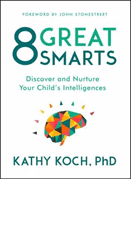
Bible Verses to Read to Your Kids on Christmas
Take the time as a family dive into the Word and help further set the stage for what is to come on Christmas. Here are some bible verses to read to your kids this Christmas Eve.
July 22, 2016

Learn about eight “smarts” that will help you recognize your children’s interests and abilities and help you strengthen them.
Everyone wants to be smart — I want to be; you want to be, and so do your children. And the good news is . . we all are.
In 1983, Dr. Howard Gardner of Harvard University published his first book about the theory of multiple intelligences. His research established that each of us is born with the capacity to develop eight different smarts. This understanding is more accurate and much more powerful than the simple right-brain, left-brain explanation.
What are these multiple smarts? Word, logic, picture, music, body, nature, people and self. Be encouraged! Most people have many strengths.
Smarts especially become strong when they’re awakened early because interest leads to ability. God intentionally creates children the way He wants them to be, dividing their brain cells into the eight different smarts (among many other things He does). Parents, grandparents and teachers get to partner with Him to develop children’s minds because what we do with our children awakens the brain. It must be nurtured. What a privilege!

Discover and nurture your child's intelligences.
As a parent, you can find your children’s natural bent by observing their interest levels and abilities. Consider what they do when no one is watching and how often they do various activities of their own volition. What topics do they like talking about and what consistently gets them into trouble? Through these patterns of activities, abilities and choices, not isolated occurrences, your children demonstrate their unique blend of intelligence.
Let’s look at some details about the eight smarts to help you recognize your children’s current interests and abilities and what you can do to further awaken and strengthen them all.
Word-smart children talk to help themselves think; if they get excited about something, they talk more. They talk as they play — to everyone or no one in particular. Although they don’t always need an audience, parents are often exhausted by the nonstop flow of words from word-smart children. As you may have guessed, these kids think with words; they often become good readers, and school is a natural fit.
Nurturing word-smart kids: Reading out loud to these kids helps to strengthen this intelligence. Try to find writing opportunities for them that are based in real tasks that matter in everyday life. As you encourage your children to ask questions, answer questions and talk about ideas learned elsewhere, you can help them work on their character and learn to listen.
How Am I Smart?: A Parent’s Guide to Multiple Intelligences
Logic-smart kids want to make sense out of their world. They think in questions, and when they get excited, they ask more questions. Logic-smart children prefer to talk about issues worth understanding. When they have nothing to think about, boredom sets in quickly. When they are confused, they may ask, “Why?” which some might misinterpret as defiance. It can be, but it’s not always. They might just want to know the reason so they have a better understanding of the situation.
Nurturing logic-smart kids: Encourage them by supplying puzzles they can solve through reasoning, talk with them about “what-if” scenarios and help them delve into nonfiction books. As a parent, you may need to work to keep them engaged, and some of their “experiments” to figure out things may leave messes. Teach them how to clean up after themselves so they can still dive into theories without people becoming angry.
Picture-smart children constantly see pictures in their mind. Most also enjoy creating pictures on paper — hopefully not wallpaper! When they’re excited by something, they add more color or objects to the pictures in their minds and on paper. They are able to visualize things in their minds partly because they use their eyes to observe the environment around them.
Nurturing picture-smart kids: You can help them grow in their intelligence through looking at diagrams, maps and charts, photographs and illustrations and objects that interest them. Images help them engage in the world around them, but they can also be easily distracted by what they see. Color with them, build with LEGO bricks or use manipulatives to engage them in learning. Consider visiting museums and exploring your area so they have more pictures to see when they close their eyes.
Rhythms and melodies are a part of music-smart children’s lives. When they’re excited, they make music. Their expression of music and rhythms fill their world with noise and their mind with enjoyable patterns. Sometimes this is recognized by their mimicking of a beat or singing in public, not caring who hears. You would think that this child would love music lessons. Some do and some don’t. Remember, all smarts are a combination of interest and ability. Some children have high interest and high ability, but it’s possible to have high interest and not want to develop ability.
Nurturing music-smart kids: You can help strengthen this smart by playing good music softly in the background of your home. Then talk with them about different musical styles and attend concerts that showcase these styles. Especially when you see evidence of ability, consider private music lessons for a while, even if they don’t like the discipline of practicing. They may begin liking it when some ability is developed.
Body–smart children excel in the areas of large-motor and/or small-motor movement and hands-on touch. It’s how they learn and respond to emotions. They move and touch more when they’re excited about something. When they are given the space and freedom to move, they are often more focused even though it may not look like it to you. Therefore, they’re also more productive. Accomplishing physical goals gives them great joy.
Nurturing body-smart kids: You can encourage children in this smart through doing activities that will improve their balance, flexibility, coordination, strength, perseverance, dexterity and quick reflexes. When you support their interests, they are likely to increase in their abilities. Of course, being active in your lifestyle to model this behavior and involving your child in it are key. Also, they can march as they spell words or “write” their spelling words in the air, using lots of muscle movement, to better remember them. Engage them in active learning.
Nature-smart children like going outside to respect and appreciate plants and animals in active ways that make them more than just observers. This is especially true when they’re excited about something — time outside energizes them. Within nature, and even with cultural artifacts like cars and sneakers, they find and observe patterns. They are also more aware of their surroundings than most kids and find weather interesting.
Nurturing nature-smart kids: Research answers to nature questions and allow a lot of outdoor exploration. As you encourage them to see the details in the world around them — in animals, plants and the landscape — use words that move their attention to designs and the elements. Then use games and activities that help them see similarities and differences — comparing and contrasting things in nature. Of course, technology may delay a child’s embracing of this smart, and being inside for too long can make them grumpy. So set their limits accordingly.
People-smart children do their best thinking when they are with people. They need people — for listening and for reacting to their ideas. Unlike word-smart children, who don’t necessarily need an audience for all their words, people-smart children do. This will be especially noticeable when they’re excited. Sharing with others gives them great joy. People increase their productivity and excellence. Their strengths include reading body language and facial expressions well and responding to them appropriately.
Nurturing people-smart kids: You can strengthen children in this area of intelligence by helping them better understand facial expressions, tones of voice and body language. Once again, technology can delay children’s ability to be people smart. To awaken and strengthen this smart, have children spend less time with technology and hold more conversations with others — including you. The better they know how to pick up on the cues that others give, the better they are able to minister to them.
Deep reflection is the strength and need of self-smart children. And once they have fully reflected on an idea or issue, they will want to apply what they’ve learned to their own lives. This type of self-motivation is derived from a lot of alone time in an area that has quiet, peace and privacy. That’s also what they crave when they’re excited by things to think about. Understanding ideas in depth brings them joy. Sometimes people are distracting to them and keep them from being able to mull over ideas. This will frustrate them.
Nurturing self-smart kids: Help them by honoring their privacy and asking questions that direct what they’re thinking about. Because they directly relate what they learn to their world, it’s important to help them gain confidence in their identity. If they are secure in who they are, they’ll know what learning will interest them. Sharing with others is one of their least favorite tasks and can be stressful. By helping them get to know their teachers and other students, they will better be able to work within a group setting when needed.
* * *
Once you recognize your children’s smarts, you only have one task remaining: Raise the kids you were given and not the ones you wish you had.
Copyright © 2016 by Focus on the Family.





Dr. Kathy Koch is the founder of Celebrate Kids, Inc., where she uses her expertise in educational psychology to help parents inspire children in their unique strengths and to thrive in their identity. She is a prolific author and sought-after speaker, known for addressing contemporary challenges in parenting and education with practical, faith-integrated strategies. Her work emphasizes the integration of Christian principles, aiming to foster character growth, identity formation, and spiritual development in children. You can learn more at www.CelebrateKids.com.

Take the time as a family dive into the Word and help further set the stage for what is to come on Christmas. Here are some bible verses to read to your kids this Christmas Eve.

Teaching children to be grateful and generous is a Christmas gift that can last a lifetime.

What questions should you ask your future son-in-law? Answers to these 12 questions might help you know whether to bless the union. Understanding what kind of man your future son-in-law is an important part of welcoming him into your family.